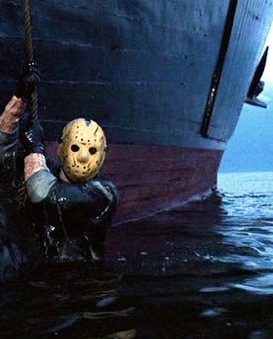Friday, August 11, 1989.
FRIDAY THE 13th PART VIII - JASON TAKES MANHATTAN. Music by Fred Mollin. Written and directed by Rob Hedden. Running time: 100 minutes. Restricted entertainment with the B.C. Classifier’s warning : frequent gory violence.
IT'S NO COMPETITION. Down on Elm Street, they're busting a gut — literally — to maintain the momentum of the screen's most imaginative scream series.
Over on Crystal Lake, they're just going through the motions. Indeed, the only interesting thing about Friday the 13th Part VIII - Jason Takes Manhattan is the fact that it was filmed in Vancouver.
A dim, entirely routine rerun of the clomp-and-kill formula, Part VIII offers filmgoers the dubious pleasure of spotting local back alleys and seeing a graffiti-scarred SkyTrain doubling for the New York subway. Much of the mayhem takes place aboard the steamer SS Lazarus, scenes shot aboard the derelict Prince George, a B.C.-built passenger liner once part of the Canadian National Steamship fleet.
Writer-director Rob Hedden’s story has the homicidal Jason (Kane Hodder) rising from his watery grave to join the grad class of Lakeview High on their voyage down the coast to New York City. The first of the franchise features not shot in the U.S., it provides a big screen credit for at least seven Canadian actors.
The group includes Todd Shaffer (as Jim Miller, the teen who unwittingly reawakens Jason), Sharlene Martin, Martin Cummins, Gordon Currie and Saffron Henderson (playing cruise ship passengers Tamara Mason, Wayne Webber, Miles Wolfe and J.J. Jarrett) with Alex Diakun as a deckhand and Michael Benyaer as Big Apple gangbanger JoJo.
The year is 2002, and Jason is now 42. Though showing some middle-age spread, he still manages to dispatch 17 hapless citizens, including all of the above-named Canadians. For those keeping score, two additional violent deaths bring the film’s total to 19: five women and 14 men.
By comparison, Freddy Krueger (Robert Englund) seems positively pleasant on this outing. A mere three characters die in A Nightmare on Elm Street 5: The Dream Child.
Unlike the Crystal Lake crowd, Freddy's handlers enthusiastically explore the fright fantasy possibilities built into his dreamworld habitat. In the process, they touch on a real issue — teen pregnancy.
Alice Johnson (Lisa Wilcox), the schoolgirl who defeated Freddy in 1988’s Elm Street 4, is now with child by her boyfriend, Dan Jordan (Danny Hassel). The conception is a blessed event for the much weakened "child of 100 maniacs."
Babies, you see, dream in the womb. Before Alice is even aware of her condition, Freddy is using her unborn child as a route back into her life.
Building on what's been revealed about Freddy in previous pictures, screenwriter Leslie Bohem makes a major character out of the undead villain's mother, raped nun Amanda Krueger (Vancouver’s Beatrice Boepple). The film opens with mom-to-be Alice meeting the mom-that-was in the abandoned ruins of the Springwood Asylum.
Under the direction of Jamaican-born Australian Stephen Hopkins, the emphasis is on eye-dazzling special effects. Never mind that a small town in middle America seems to have an empty loony bin that looks like Dracula's castle.
The object is to bring bad dreams to life and considerable technical expertise is used to do just that. A competently-crafted shock feature, it puts the pro-choice option in a new light.
The above is a restored version of a Province review by Michael Walsh originally published in 1989. For additional information on this archived material, please visit my FAQ.
Afterword: At the risk of going all political here, it’s hard not to notice that the era of violent horror-film franchises ran parallel to the Ronald Reagan presidency. The dark forces that John Carpenter unleashed with his 1978 feature Halloween — embodied in the teen-targeting homicidal maniac Michael Meyers — foreshadowed the “voodoo economics” at the heart of the Great Communicator’s “conservatism.” Sean S. Cunningham’s Friday the 13th was released in 1980, the year of his election, and Reagan’s “Morning in America” was followed by Wes Craven’s Nightmare on Elm Street (1984). It's a point that has been made by a number of social and cultural historians.
Less remarked upon are the effects of “Reaganomics” on the emergence of Vancouver as a major filmmaking and television production centre. The rise of Ronald was accompanied by a decline in the value of the Canadian dollar. By 1986, it had dropped to 72 cents U.S., and that made our relatively mature entertainment service infrastructure particularly attractive to cost-conscious Hollywood. They came, they saw and, unlike the hapless American troops that stormed Queenston Heights in 1812, they stayed. Today, a significant percentage of the shows seen on U.S. screens are filmed in British Columbia. No surprise, then, that when Jason Voorhees made his second visit to Vancouver he brought along his frenemy Freddy. The hockey-masked murderer from the Friday the 13th franchise faced off with the Elm Street fiend in Freddy vs. Jason, a 2003 crossover feature directed by Hong Kong action expert Ronny Yu. It was the last entry in each of the franchises prior to their respective reboots (in 2009 for Friday the 13th; 2010 for A Nightmare on Elm Street).
